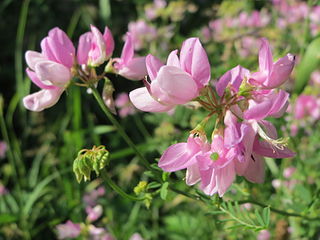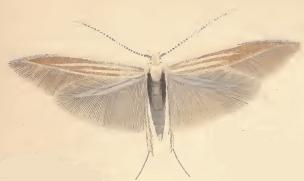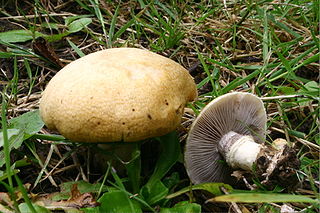
Securigera varia, commonly known as crownvetch or purple crown vetch, is a low-growing legume vine. It is native to Africa, Asia and Europe and is commonly used throughout the United States and Canada for erosion control, roadside planting and soil rehabilitation. It has become an invasive species in many states of the US.

The Coleophoridae are a family of small moths, belonging to the huge superfamily Gelechioidea. Collectively known as case-bearers, casebearing moths or case moths, this family is represented on all continents, but the majority are found in temperate areas of the Northern Hemisphere. They are most common in the Palearctic, and rare in sub-Saharan Africa, South America, and Australia; consequently, they probably originated in northern Eurasia. They are relatively common in houses, they seek out moist areas to rest and procreate.

Coleophora is a very large genus of moths of the family Coleophoridae. It contains some 1,350 described species. The genus is represented on all continents, but the majority are found in the Nearctic and Palaearctic regions. Many authors have tried splitting the genus into numerous smaller ones, but most of these have not become widely accepted.

The tribe Loteae is a subdivision of the plant family Fabaceae, in the Robinioids. These genera are recognized by the USDA:

The genus Securigera contains a number of plant species commonly referred to as crownvetch. It is a segregate of the genus Coronilla. The name Securigera was first published by A. P. de Candolle in 1805 with the single species Securigera coronilla, which is now considered to be a synonym of Securigera securidaca(L.) Degen & Dörfl. (1897), based on the earlier publication of the same taxon as Coronilla securidacaL. in 1753.

The genus Coronilla contains 8 species of flowering plants native to Europe and North Africa. It contained about 20 species before being split into Securigera.

Aínsa-Sobrarbe is a municipality located in the province of Huesca, Aragon, Spain. As of 2010 (INE), the municipality has a population of 2,180 inhabitants.

Trifurcula cryptella is a moth of the family Nepticulidae. It is widespread throughout Europe, northwards to southern parts of Norway and Sweden, eastwards to Poland and the Balkan Peninsula, and south to the Mediterranean countries, but there it is rare and confined to mountainous regions. In Italy it has only been recorded from the northern part, in Portugal in the Serra da Estrêla, in Spain in the Cantabrian Mountains and possibly the Sierra Nevada. It is absent from the Mediterranean islands.
Trifurcula ortneri is a moth of the family Nepticulidae. It is widespread in the western Mediterranean region, where it is known from the Algarve in Portugal, Spain, France and Italy. It has also been recorded from Croatia (Dalmatia), Morocco and Algeria, eastern Austria, Hungary, Slovakia and Germany.

The metallic coleophora moth is a moth of the family Coleophoridae. It is native to Europe and Armenia, but is an adventive species in the Nearctic realm, where it is found throughout the United States and southern Canada. It has also been recorded from New Zealand, Chile and Argentina.
Coleophora vicinella is a moth of the family Coleophoridae. It is found from France to Ukraine and then further south.

Coleophora trifariella is a moth of the family Coleophoridae. It is found from Germany and Poland to the Iberian Peninsula and Italy and from France to Romania. There is a disjunct population in Belarus. It is also known from Turkey.
Coleophora sisteronica is a moth of the family Coleophoridae. It is found in southern France, Spain and Italy.

Coleophora colutella is a moth of the family Coleophoridae. It is found in all of Europe, except Great Britain and Ireland. It is an introduced species in North America.

Coleophora coronillae is a moth of the family Coleophoridae. It is found from Germany to Italy and Bulgaria and from Lithuania to the Iberian Peninsula. It is also found in southern Russia, Transcaucasia, central Asia and Iran.
Coleophora fuscociliella is a moth of the family Coleophoridae. It is found from Germany and Poland to Italy, North Macedonia, and Romania. It is also known in southern Russia.
Coleophora oriolella is a moth of the family Coleophoridae. It is found in Germany and Poland to the Iberian Peninsula, Sardinia, Sicily and Greece and from France to southern Russia.

Lygephila viciae is a moth of the family Erebidae. It is found in most of Europe.

Stropharia coronilla, commonly known as the garland roundhead or garland stropharia, is a species of mushroom native to Europe and North America. It is considered poisonous, and is sometimes mistaken for species of Agaricus.











